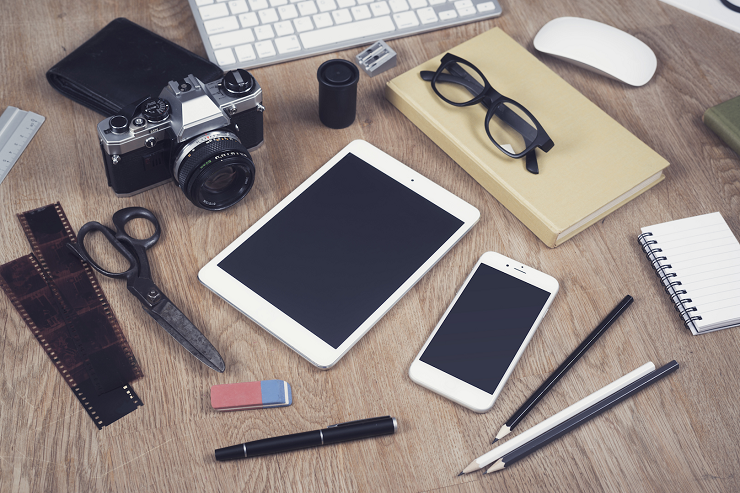Communicators tend to think of themselves as wordsmiths, whether it’s writing press releases or thought leadership articles. Nowadays the demand for photography and video skills are rising, given that nearly everyone owns a photography studio in the form of a smartphone. The question is how to do you take better pictures?
Yes, by all means, hire a pro if you possibly can. Professional-quality photos or video matter. Sometimes, though, you’re forced to snap a shot. In a time of shareable images, the old style no longer works — grip-and-grin pictures of donors handing over giant checks, St. Valentine’s Day Massacre lineups of executives.
We sought out tips from professional photographers and videographers. Here are a few of them:
1. Get closer.
The famous war photographer Robert Capa once advised, “If your photographs aren’t good enough, you’re not close enough.”
Of course, he also died on the job when he stepped on a landmine, notes Kristin Griffin of Kristin Griffin Photography. Given that most of us won’t be tromping across minefields, the advice holds for organizational photographers.
2. Set the scene with your shots.
Shoot from far away, medium distance and close up, says Alyssa Craft, a videographer with Pure Living for Life. This is essential with video but also matters in still photography.
Example: Shoot a high-level overview of a farmers market, a person at a booth in said farmers market and a detail such as a close-up of a child getting her face painted. “With these three shots in mind you can really capture emotion in an event with just a few photos,” Craft says.
3. Fill the frame.
You know those photos where your subject is standing three miles away (or so it seems), surrounded by extraneous space? Don’t do that.
“When photographing a person, use the whole frame,” says photographer Joel H. Mark. “Try not to put the head at the center of the frame.”
4. Apply the rule of thirds.
Photographers consider this a basic tip, but many beginners don’t know it. Start with your subject a third of the way from either the left or the right side of your frame, Craft says. “That said,” she adds, “rules exist to be broken.” First, though, you must learn them.
5. Look for the light.
The most important tip for amateur photographers is always look for the light, says Travis Johansen, producer, director of photography and video editor at Provid Films.
“What differentiates a photo that stands out is one where the subject looks amazing,” Johansen says, “and it’s the light that does it.”
Photographer and cinematographer Jon Kline adds that you should move your subject near the light. “More light means less noise, truer colors and sharper photos,” he says. “The best light is usually near a window. When taking a photo, put the window at your back, and move the subject close, but not into direct sunlight.”
6. Get down and dirty.
Try different angles, which may require you to get a little grubby, suggests Alice Bil, owner-photographer of studioEPIC photography. If you kneel or lie on the ground, buildings will appear taller and more majestic. If you’re worried about messing up your outfit, bring a small blanket or scarf, she says.
Alternatively, climb a tree or wall. Portraits especially of children or pets-can be stunning when shot from a higher elevation. “The subject looks more vulnerable, and their eyes widen when they look up at you,” Bil says.
Group shots are also better if you stand above — say, on a staircase — and shoot down, says Mark Alves, digital strategist with Alves Consulting. This allows you to avoid unflattering squatting poses.
7. Crop and filter.
Instagram brings good news and bad news: It raises the bar for professional photography, but lowers it for what will pass as a useable photo, Johansen says. With Instagram, anyone can learn how to compose images and have them look good without spending weeks and tons of money on film.
“Crop and filter before posting,” says Barak Kassar, co-founder of BKW Partners. “It’s not always possible to get a great shot, so take some time to remove extraneous bits and run it through a filter or two.”
He says Google’s Nik Collection is great at doing this, and it’s free. Get comfortable with a photo editing app on your phone, such as Enlight, so you can rescue any photo mishaps immediately on deadline.
8. Treat images like headlines.
Kassar agrees that hiring a pro is the best idea, but he urges writers to think about photos the way they do headlines and leads.
9. Watch the background.
Be hyperconscious about visual junk behind the subject, says Bill Brokaw of Brokaw Photography. “Visual junk is anything that distracts the eye — and therefore the viewer’s attention — from the actual subject,” he says. Be wary of the telephone pole that appears to be growing out of the back of your executive’s head during that outdoor shoot.
10. Use drones, Steadicams or tripods.
Shots in motion make video look professional and cinematic, says Maksym Podsolonko, owner of Magic Day Luxury Experiences. Shaky shots look cheap and unprofessional. Drones and Steadicam help you produce stunning shots.
If all that is beyond your skill level, at least get a tripod to steady your shots.
“Have fun,” Kassar adds. “It’ll make your subjects have fun, and it’ll show in the photo.”
Russell Working is a staff writer for Ragan Communications. A former reporter for the Chicago Tribune, he has also freelanced for The New York Times, The Atlantic Monthly, Columbia Journalism Review, The Boston Globe, the Los Angeles Times, the South China Morning Post, The Japan Times, and many other publications worldwide.








Russell,
Thank you for this article! Many Public Relations practitioners that I know are not formally trained in photography. Yet, somehow, taking and posting great pictures are often important parts of our jobs.
Supplemental articles like yours accompanied by training are incredibly important to ensure that we are doing our jobs to the best of our abilities. Knowing the core principles and practices of good PR is one thing, but having the basic skills to properly apply these principles and practices is a totally different ball game that is often overlooked.
Thanks again!
Anne Walther
I am the Vice-President of Public Relations for my sorority and even though we have a photographer, I often find myself taking more photos than she does. While she gets some beautiful shots, you can’t always sit around and pose your subjects. I find that action shots or photos of our members doing the work gets the most reaction on our social media accounts.
I found tip #1 to be the most useful to the kind of photography that our chapter utilizes. Often times there is too much background and we’re not close enough to our subjects. I also found tip #9 to also be very useful. Since our shots generally have a lot of space in the background it’s easy to get things in the background that could distract from the purpose of the photo.
I do also agree with you that it is becoming more and more important for PR professionals, and many others, to have photo and video skills. As our markets grow to be more and more digitally connected, it is important that we to grow and stay digitally connected with our consumers. While it’s not impossible to have a digital presence without photos and videos, I feel that it would make consumers less likely to interact with the brand.
Thank you for featuring my tips in your article!